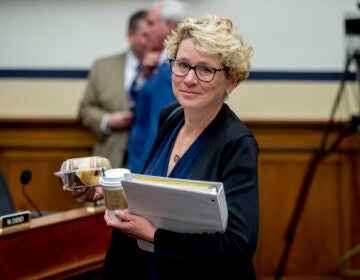Pa. lawmakers prepare for a month of intense redistricting negotiations
Lawmakers are already working against the clock. Pandemic-induced census delays meant they received the data to draw maps much later than usual.

The Pennsylvania State Capitol building on Monday, June 22, 2020. (Gov. Tom Wolf/Flickr)
Lawmakers in charge of redrawing Pennsylvania’s congressional maps are hoping to release their proposals within the next two weeks.
However, points of contention still remain between Republicans and Democrats, and staffers with firsthand knowledge of the process say it is still unclear which map drafts legislative leaders will choose.
“There’s certain sections of the state that are done,” said Sen. Sharif Street (D-Philadelphia) who serves as minority chair of his chamber’s State Government Committee, which is in charge of drafting maps.
“There’s a lot of agreement on some things,” he added, noting that Republican and Democratic staffers on his committee are “working together to take the ideas that we’re getting from members from across the state and trying to synthesize something that we can call a draft map.”
Hundreds of small decisions go into the drawing of congressional and state House and Senate maps.
Some counties and municipalities inevitably need to be split in order to make districts with proportional numbers of people in them. But which ones, and where? How should lawmakers define “communities of interest” and which are best kept together? How exact do mapmakers need to be when they’re making districts the same size? Within ten people? Fifty?
For months, the lawmakers and staffers in the House, Senate, and governor’s office have been holding public hearings to collect constituent feedback on these and other questions.
Lawmakers are already working against the clock. Pandemic-induced census delays meant they received the data to draw maps much later than usual.
Notwithstanding, both the House and Senate have promised a process that is far more transparent than previous years’ generally secretive efforts, which the courts ruled in 2018 were baldly partisan and unconstitutional.
As lawmakers get ready to release their legislative and congressional draft maps, here’s what the public can expect.
House and Senate maps
In Pennsylvania, legislative maps are drawn by a commission made up of the leaders of all four caucuses — Senate Majority Leader Kim Ward (R-Westmoreland), and House Majority Leader Kerry Benninghoff (R-Centre), Senate Minority Leader Jay Costa (D-Allegheny), and House Minority Leader Joanna McClinton (D- Philadelphia) — along with a non-legislative tiebreaker.
Because the partisans on the Legislative Reapportionment Commission couldn’t come to a consensus, the state Supreme Court took over that decision, appointing Mark Nordenberg, the former dean of the University of Pittsburgh’s law school.
Those five members abide by a fairly strict, constitutionally-mandated timeline.
Once they receive detailed election data and hold a vote to officially deem it usable, they kick off a 90-day period in which they must create and disseminate preliminary maps, which are released for 30 days of public comment. Then, the committee takes a final vote on the plans, and there’s a final 30-day period for appeals to the Pennsylvania Supreme Court.
Already, the legislative members of the committee have clashed several times, most significantly on changing the way Pennsylvania counts people in state prisons.
Nordenberg had to be the tiebreaker. In the prison case, for instance, he initially sided with Democrats, voting to no longer count many state prisoners as residents of the districts where they’re incarcerated, but rather as residents of the districts where they originally lived. Then, he sided with Republicans in rolling back that decision somewhat, carving out people serving longer sentences.
The commission finally voted on Oct. 25 to approve its population data, starting the timer on their negotiations. Nordenberg noted at the time, he hoped to release a preliminary plan “much sooner” than the 90-day timeline the constitution allows.
Congressional maps
Unlike the legislative maps, the congressional lines are drawn by the GOP-controlled House and Senate, and must be signed by Democratic Gov. Tom Wolf.
They don’t have as firm a deadline as the Legislative Reapportionment Commission, but they do have time constraints. The Department of State told lawmakers they must finalize their maps by Jan. 24 in order to allow enough time for candidates to circulate nominating petitions ahead of the 2022 primary on May 17.
Street and GOP staffers confirmed they think there may be some wiggle room if negotiations don’t go well, but they’re also keeping open the possibility of moving the primary date.
“A goal of ours is to not have to do that, but you know, those are decisions that leaders will make when the time comes,” Street said.
One legislative staffer with close knowledge of the process who didn’t want to be named says he’d like to release legislation that includes a formal draft map as soon as this week, but added that may not be realistic.
He and Street confirmed that the House and Senate plan to give Pennsylvanians most of December to make public comments, then lawmakers will hold formal hearings, adjust the maps, and hopefully vote on them in early January.
That doesn’t allow much room for error, or for a breakdown in negotiations between the four caucuses and the governor, and Street acknowledges that nothing “is set in stone.”
Wolf has issued his own guidance on principles he would like to see followed in the new map. The governor assembled his own “Pennsylvania Redistricting Advisory Council,” made up of experts who held hearings and, the day before Thanksgiving, released a set of findings.
His wish list includes uncontroversial standards, like making districts as equal in population as possible, compact, and contiguous. But he also included several points likely to raise GOP hackles, like a note that “the congressional delegation should be proportional to statewide voter preference” and that the map should be “responsive to changing voter preference.”
As of Nov. 22, DOS reports that of the more than 8.7 million registered voters in Pennsylvania, about 3.4 million are registered Republicans and four million are Democrats.
Statewide races, though, have often flipped between the parties in recent years.
But because many Democratic voters in Pennsylvania live in a few urban centers, their voting power gets diluted under many congressional maps. Republicans tend to hold that up as a key reason why congressional maps in the commonwealth often favor their candidates and cannot truly reflect voter registration statistics. Currently, the state’s 18-member congressional delegation reflects an even partisan split, with Democrats gaining ground after the Pa. Supreme Court redrew the map in 2018.
Both Senate caucuses pointed to one particular area of the map as a likely sticking point: Central PA, particularly the three smallish, liberal cities that sit amid more conservative suburbs and rural areas: Harrisburg, Lancaster, and York.
Behind the scenes, Democrats have pushed to combine Harrisburg with one of those other cities into a single district, which would make it competitive for them and, they argue, better represent the diverse, largely Democratic-voting people who live in those cities.
Street is on that side.
“We believe there should be a swing district in central Pennsylvania,” he said. “I personally think that’s a good way of doing it. Our position is that the region, given its population, should have at least a competitive district.”
Republicans, the legislative staffer confirmed, have balked, arguing it would inappropriately lump disparate areas together.
It’s just one of many potential issues that will likely arise when members actually put their map to a vote, then ask the governor to sign it. But Street said despite the short timeline and differences of opinion, he feels pretty good about the process.
“I am cautiously optimistic, pending us actually having a map which can then go into a bill,” he said. “Unlike a lot of other things, this process is pretty fair and bipartisan, and I think the spirit of the negotiations reflects that.”
WHYY is your source for fact-based, in-depth journalism and information. As a nonprofit organization, we rely on financial support from readers like you. Please give today.








